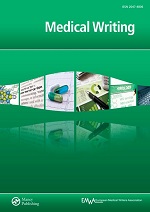
Volume 24, Issue 4 - Writing for Lay Audiences
Gained in Translation
Authors: Laura C. Collada Ali, Lorenzo Gallego Borghini
Editorial
Welcome to the Translation Section editorial!
What we call ‘lay-friendliness’ is a key characteristic of Patient Information Sheets (PIS), which are tightly regulated on a European level to guarantee a comprehensible document that contains usable information for patients. It is clear that we, as translators, need to make an effort to improve language access as a means of empowering patients in decision-making about their own care. Strategies to support patients play an important role in understanding the causes of illness, protecting their health, and taking appropriate action. Yet, professional translators often primarily focus on the faithfulness of the translation to the original document rather than on the comprehensibility of the translated version, forgetting that often messages that work well with one language-speaking audience may not work for audiences who speak another language.
In the following article, Lorenzo Gallego Borghini gives an overview of lay-friendliness of PIS translations in Spain. Enjoy the article!
Laura C. Collada Ali
 Download the full article
Download the full article
References
- Agencia Española de Medicamentos y Productos Sanitarios (AEMPS). 2013 Memoria de actividades. Madrid: Imprenta Nacional de la AEBOE; 2014.
- Real Decreto 223/2004, de 6 de febrero, por el que se regulan los ensayos clínicos con medicamentos. Madrid: Boletín Oficial del Estado; 2004.
- Ordovás Baines JP, et al. Analysis of the written patient information forms to obtain informed consent in clinical trials. Med Clin (Barc). 1999;112:90–94.
- Galende Domínguez I. Listas guía para la evaluación de protocolos de investigación clínica. In: Galende Domínguez I (coord.). Guías operativas para los CEI-II: Evaluación de protocolos de investigación biomédica. Madrid: Fundación AstraZeneca; 2007.
- Gálvez Múgica MA, De Pablo López de Abechuco I. Evaluation process of a clinical trial from the EC's point of view. Rev Clin Esp. 2007;207(1):29–33.
- López Parra M, Moreno Quiroga C, Lechuga Pérez J. A review of the most frequent objections made to patient information sheets of clinical trials. Medicina Clínica (Barcelona). 2012;139(4):176–179.
- Bhutta ZA. Beyond informed consent. Bulletin of the World Health Organization 2004;82(10).
- Gallego Borghini L. Analysis of the objections raised by ethics committees in Spain to the translations of clinical research patient information sheets and informed consent forms: Implications for translators. Revista de Bioética y Derecho 2015;33(1):14–27.
- López Ciruelos A. El mito de la brevedad del inglés. Panace@ 2002;3(9–10):90–95.
- Ley Orgánica 15/1999, de 13 de diciembre, de Protección de Datos de Carácter Personal. Madrid: Boletín Oficial del Estado; 1999.
- Mayoral Asensio R. A guide to translating vital records (birth and death certificates) from English to Spanish. Panace@ 2012;13(36):202–228.
- Borja Albi A. An approach to medico-legal translation. Panace@ 2012;13(36):167–175.
- Centro Coordinador de CEIC, Ministerio de Sanidad, Servicios Sociales e Igualdad. Hoja de información al paciente. Available from: http://www.msssi.gob.es/profesionales/farmacia/ceic/pdf/hojaInfoPaciente.pdf
Search
Articles
Links
Editoral Board
Editor-in-Chief
Co-Editors
Managing Editor
Victoria White
Deputy Managing Editor
Alicia Brooks Waltman
Associate Editors
Section Editors
AI/Automation
Biotechnology
Digital Communication
EMWA News
Freelancing
Gained in Translation
Getting Your Foot in the Door
Good Writing Practice
Pablo Izquierdo / Alison McIntosh
In the Bookstores
Publications
Medical Communications/Writing for Patients
Medical Devices
My First Medical Writing
News from the EMA
Pharmacovigilance
Regulatory Matters
Regulatory Public Disclosure
Louisa Ludwig-Begall / Sarah Kabani
The Crofter: Sustainable Communications
Veterinary Writing
Editors Emeritus
Layout Designer
Chris Monk
 Visit the EMWA website
Visit the EMWA website